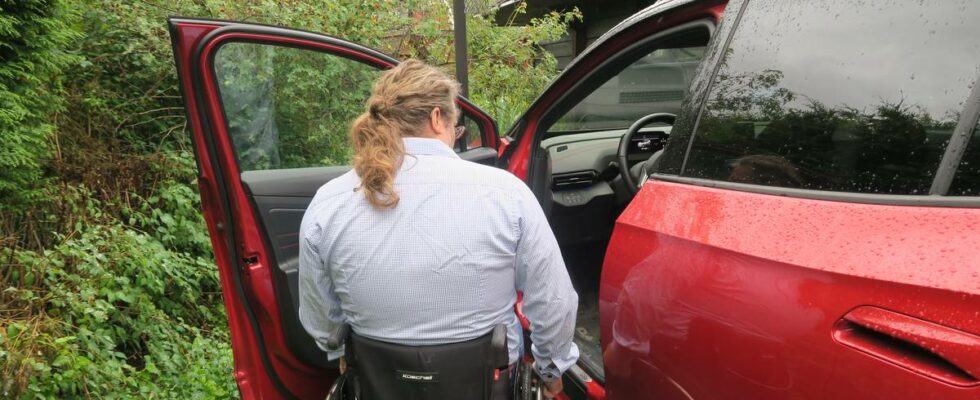Imagine that you have bought yourself a new car, quite similar to the previous one. How would you react if you had to prove again that you could drive it? Namely, Per Eugen Kristiansen had to. Per has driven a car with the same adjustments for almost 30 years, he says. Photo: Helene Hjelseth Holen / news – They demanded that I deliver a health certificate and show that I could drive the car. So says Per, who sits in a wheelchair. The demand came in a letter from the National Roads Administration, after he bought a new car last autumn. This is despite the fact that the equipment in the new car is exactly the same as in the old one. – It surprised me. Among other things, the letter stated that they could not see that I had shown that I could use that kind of equipment. But I had driven up with this equipment in 1995, says Per. The steering wheel makes it easier to steer, especially in tight spaces, says Per. Here he holds the hand gas and the brake, which means that he can drive the car with his hands. Photo: Helene Hjelseth Holen / news Ever since a climbing accident in 1994, he has been a wheelchair user. He took his driver’s license again after the accident. Since then, Per has had a rebuilt car with customized equipment. At home at Bekkestua in Bærum, there is now a shiny red Volkswagen. The car is new, but inside the equipment is the same as before. There is a ball on the steering wheel and manually controlled gas and brake. – I have to make some small adjustments to the car to make it available to me. Now I have driven with the same equipment for almost 30 years, says Per. The equipment in the old and the new car is exactly the same, Per shows. A ball on the steering wheel and a lever that controls the gas and brake. PHOTO: Helene Hjelseth Holen / news Since Per is in a wheelchair, he does not meet the health requirements for a normal driver’s license. But since he can still drive a car with the right equipment, he has a dispensation, or an exception, from this requirement. This means that his driver’s license is marked with so-called driver’s license codes. They act as a form of condition for one to be allowed to drive a car. Then you must always drive with equipment that matches the codes. Time and money Although Per has now had his driver’s license updated so that he can also drive the new car, he is left with a sense of injustice. He has reported the Swedish Road Administration to the Discrimination Board. Among other things, Per reacts to the fact that the process has cost him a lot, despite the fact that the driving assessment itself is free. – With the time I have had to take time off from work, the amount is probably close to NOK 10,000, he estimates. Confederation leader Tove Linnea Brandvik. Photo: Erik Lundby Confederation leader of the Norwegian Association for the Disabled, Tove Linnea Brandvik, says that Per is not alone. She says that more people contact the union in such cases, and that discrimination can be perceived as demanding. – Many find it frustrating, degrading and an unnecessary use of time and energy. It’s not a good feeling for anyone, says Brandvik. Per says that he has been very frustrated and irritated by the case. Photo: Helene Hjelseth Holen / news – I felt that this requirement came unilaterally to me as a wheelchair user, and not to other people who get a new car. It has required time and expenses for me that would not have been required if I were functionally fit, says Per. Matters of safety Per also had to attend a driving assessment. Here you drive together with a sensor who will assess whether you handle the equipment in the car in a road-safe and good manner. Per reacts to the way this was carried out. – The sensor looked at me, looked at the car. We drove 100 metres, and then we were done, he says. Lawyer in the Norwegian Public Roads Administration, Cathrine Håheim. Photo: Cathrine Håheim Cathrine Håheim, a lawyer in the National Road Administration, says that in some cases the examiner can discover that one should, for example, make adjustments to the equipment so that the driver can drive more safely in traffic. – We are not going to reassess the traffic competence. And we understand that in some cases it may seem completely unnecessary. It is difficult to say in advance which case it was necessary for and which was not, says Håheim. She also points to the rapid development in vehicles and technology, which means that apparently similar equipment can be handled differently for the driver. – I feel this requirement came to me unilaterally as a wheelchair user, says Per. Photo: Helene Hjelseth Holen / news Per believes it should not be necessary for him to be taken in for such a check just because he bought a new car. – They must create an automatic system so that they don’t bother people who may already have increased challenges in their everyday life. The National Roads Administration should not make it more difficult for people with disabilities to participate in society, he says. Hello! Do you have any thoughts or suggestions for the case you’ve read, or tips for other cases I should look at? Feel free to write to me! Published 11.08.2024, at 14.05
ttn-69
Meiner The National Road Administration discriminates because he is in a wheelchair – news Norway – Overview of news from different parts of the country

